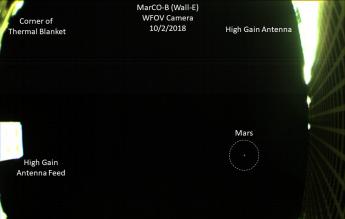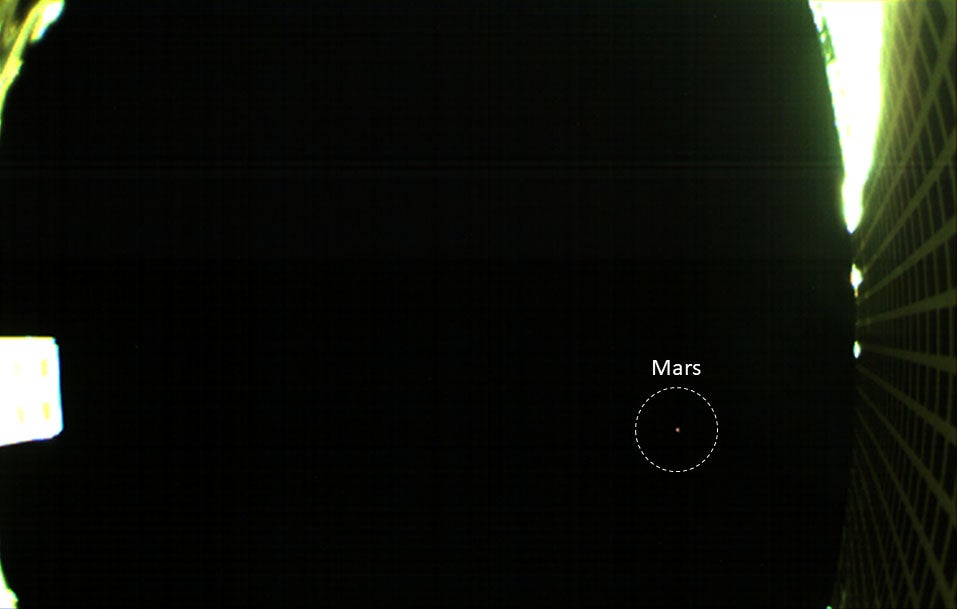Historic Mars Photo Taken by CubeSat With Cal Poly Connection

A snapshot from a cosmic road trip has made history. Wall-E, one of two identical briefcase-size satellites that underwent testing and preparation at Cal Poly earlier in the year for an historic mission to Mars, took a photo of the Red Planet — nearly 250 million miles from Earth.
The two satellites are officially called MarCO-A and MarCO-B (MarCO stands for Mars Cube One) — but their engineering teams nicknamed them “EVE” and “Wall-E” respectively. Wall-E’s wide-angle camera captured the image of Mars on Oct. 3 as a test of exposure settings — the first image of the Red Planet ever produced by this class of tiny, low-cost spacecraft.
MarCO-B’s camera looks straight out from the deck of the CubeSat. Parts related to the spacecraft’s high-gain antenna are visible on either side of the image. Mars appears as a small red dot at the right of the image. To take the image, engineers had to program the CubeSat to rotate in space so that the deck of its boxy “body” pointed at Mars. After several test images, they were excited to see that clear, red pinprick.
The MarCO mission, led by NASA’s Jet Propulsion Laboratory in Pasadena, Calif., hopes to produce more images as the CubeSats approach Mars ahead of the planned Nov. 26 flyby of the planet. That’s when they’ll demonstrate their communications capabilities while NASA’s InSight spacecraft attempts to land on the Red Planet. (InSight won’t rely on them, however; NASA’s Mars orbiters will be relaying the spacecraft’s data back to Earth.)
The image was taken from a distance of roughly 8 million miles (12.8 million kilometers) from Mars. The MarCOs are “chasing” Mars, which is a moving target as it orbits the Sun, according to JPL. In order to be in place for InSight’s landing on Cyber Monday, the CubeSats still have about 53 million miles (85 million kilometers) to cover. They have already traveled 248 million miles (399 million kilometers).
“We’ve been waiting six months to get to Mars,” said Cody Colley, MarCO’s mission manager at JPL. “The cruise phase of the mission is always difficult, so you take all the small wins when they come. Finally seeing the planet is definitely a big win for the team.”
MarCO are the first CubeSats to travel to deep space.
“Nobody would have imagined that 10 or 20 years ago,” said Ryan Nugent, a staff aerospace engineer at Cal Poly.
CubeSats are based on a standardized small size and modular use of off-the-shelf technologies. Many have been made by university students — including high school students — since the standard was created by a Cal Poly professor and his counterpart at Stanford University in 1999 in order to promote and develop the skills necessary for creating small satellites intended for low Earth orbit operations.
Since the first CubeSat was launched in 2003, more than 700 have been lifted off into Earth orbit as secondary payloads on launches of larger spacecraft.
MarCO — 12 inches tall, 4-inches deep and 8-inches wide — arrived on the Cal Poly campus Feb. 28. Over the next 17 days, engineers from Cal Poly and the Jet Propulsion Laboratory assisted in inserting, or integrating, the satellites into the deployment boxes that will eject each CubeSat into space. In addition, Cal Poly students also spent nearly 15 hours wrapping the deployment boxes in protective gold aluminized Kapton tape.
The satellites launched May 5 from Vandenberg Air Force Base on the same United Launch Alliance Atlas V rocket as NASA’s Interior Exploration using Seismic Investigations, Geodesy and Heat Transport lander. InSight is NASA’s first mission devoted to understanding the interior structure of the Red Planet — and the first interplanetary mission to launch from the West Coast.





